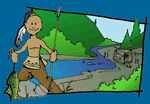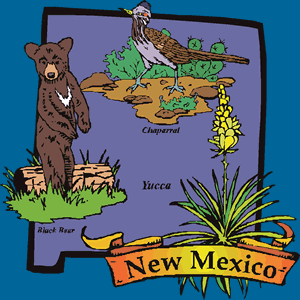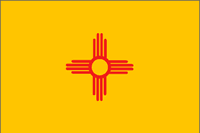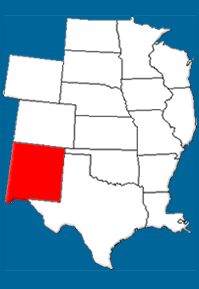


Geography and Landforms:
The state of New Mexico consists of four land regions - the Great Plains, the Colorado Plateau, the Rocky Mountains, and the Basin and Range region.
|
 History:
The first European to reach what is now the state of New Mexico was Cabeza de Vaca. De Vaca was part of an expedition in search of gold in Florida. When their ship wrecked just off the Texas coast, they came ashore and wandered across southern New Mexico between 1528 and 1536. The expedition encountered the pueblo villages of the Native Americans and brought word back to the Spanish of their experiences.
|
 Economy:
Agriculture provides a considerable source of income for New Mexico. The most important agricultural industry is ranching. Ranches throughout the state make use of land that is too steep or too rocky for growing crops. Cattle and sheep thrive on the open range year round. Major crops of hay and sorghum are grown in the dry climate. Pinto beans, pinon nuts, and chili peppers are also raised.
|
 First Inhabitants:
The earliest established culture in New Mexico was that of the Pueblos, a sedentary group of Native Americans who flourished in farming communities. They included the Mogollon, who lived in the valleys of the area that is now the New Mexico-Arizona border between 500 BC and 1200 AD, and the Anasazi.
|
Books Related To New MexicoE is for Enchantment: A New Mexico Alphabet - Helen Foster James The Gadget - Paul Zindel Harvey Girl - Sheila Wood Foard Josefina's Surprise - Valerie Tripp Kokopellis' Flute - Will Hobbs The Last Snake Runner - Kimberley Little Muchacho - LouAnne Johnson The Night of Las Posadas - Tomie dePaola The Staircase - Ann Rinaldi Surprising Cecilia - Denise Gonzales Abraham Tiger Eyes - Judy Blume White Sands: Red Menace - Ellen Klages |
Famous Citizens:
|
| Capital: | Santa Fe |
| Entered Union: | January 6, 1912 |
| Population: | 2,085,572 |
| Area | 121,589 |
| Bird | Roadrunner |
| Flower | Yucca Flower |
| Nickname: | Land of Enchantment |
| Governor | Susana Martinez |
Places to Visit in New Mexico: (Click the links to learn more.)
|



